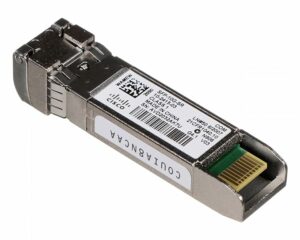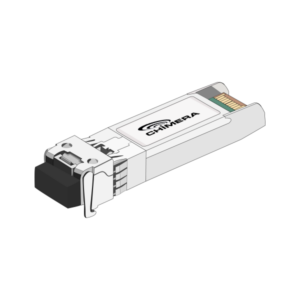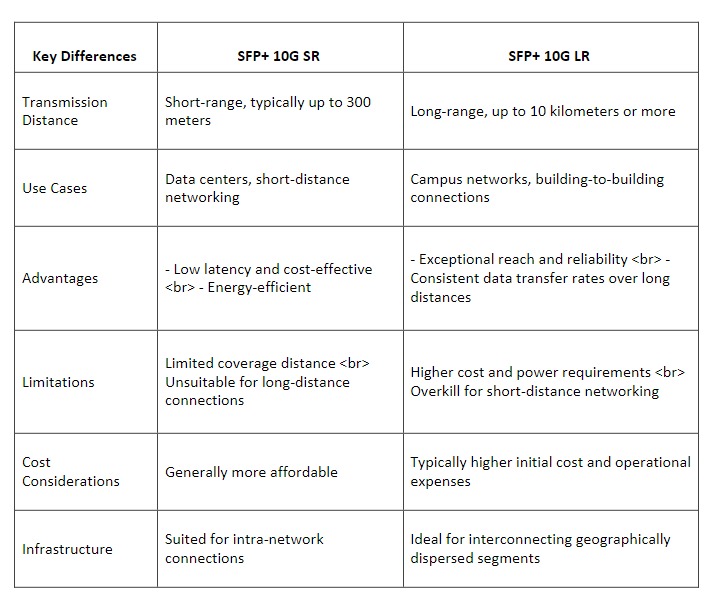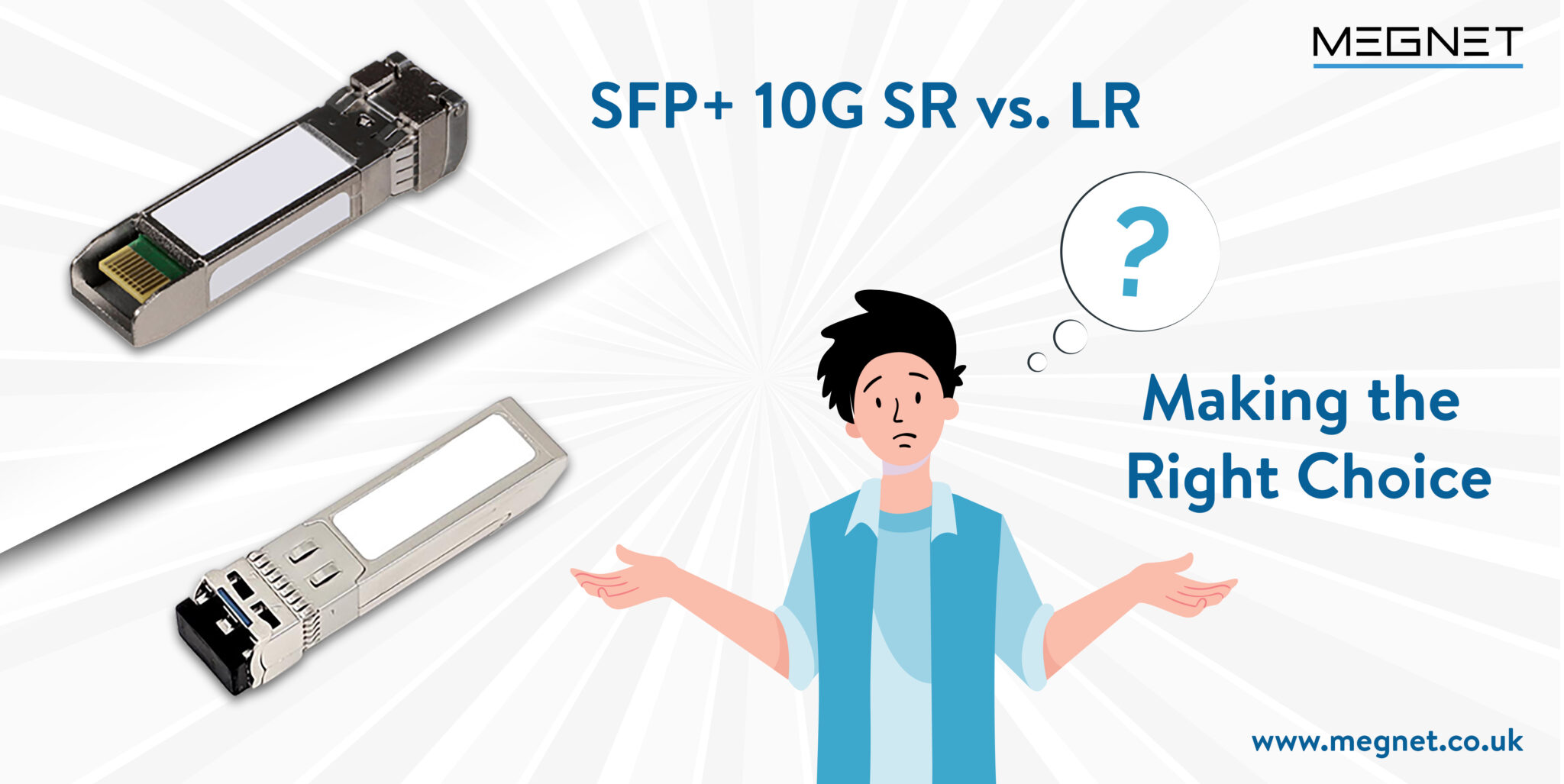
In today’s ever-connected world, choosing the right optical transceiver module can make or break your network. This article explores the critical decision of whether to opt for SFP+ 10G SR or LR modules. These small form-factor pluggable modules play a pivotal role in high-speed data transmission.
A wrong choice can lead to network inefficiencies and increased costs.
In this blog, let’s dive into the intricacies of these modules, comparing their technical specifications, use cases, and cost implications. By the end, you’ll be equipped with the knowledge to make an informed decision, ensuring your network operates at its best. 
What is SFP+ 10G SR (Short-Range) ?
The standard option for short-distance network connections, which often span within data centers or business contexts, is SFP+ 10G SR modules. These modules are perfect for high-demand applications like data storage and video streaming in constrained places because they provide excellent data transfer speeds and minimal latency.
They support overall network sustainability by being economical and energy-efficient. However, because of their short range, SR modules are inappropriate for longer connections across campuses or between buildings. Their sweet spot is optimal short-range performance, which boosts intra-network effectiveness.

What is SFP+ 10G LR (Long-Range) ?
The SFP+ 10G LR modules have been designed to provide long-distance connectivity, enabling communication across extensive distances such as between campuses, buildings, or even across a whole city. These tools demonstrate remarkable range and dependability, rendering them essential in situations where distance plays a crucial role.
The LR modules exhibit reliable and stable data transmission speeds, as well as little signal degradation, even while transmitting data over long distances, hence assuring the integrity of the sent data.
Nevertheless, it is worth noting that these modules often exhibit higher costs and need more power consumption in comparison to SR modules.
One of their notable advantages is their ability to establish connections between network parts that are geographically far from each other, rendering them a strategic option for enterprises that possess extensive infrastructure requirements.
Know more about Cisco 10GBASE SFP+ Transceivers in this article.
Key Differences
To make the right choice, it’s essential to grasp the key distinctions between SR and LR modules.

Factors to consider when choosing between SFP+ 10G SR and LR modules
Distance Requirements:
Find out how far your optical link has to go. Short-range (SR) modules may be used for connections up to 300 meters in length, making them ideal for use in data centers and other indoor environments.
Long-range (or LR) modules are built for transmissions that reach many kilometers. For optimum performance, it is essential to select the module that corresponds to your distance requirements.
Network Infrastructure:
Assess the current network infrastructure in place. The examination encompasses the aspects of topology, cabling, and architecture.
SR modules are well-suited for establishing connections inside a network that necessitate short distances and fast speeds.
On the other, LR modules provide exceptional performance in situations that necessitate the interconnection of network segments that are geographically distant, such as the integration of buildings within a campus environment.
Compatibility:
Check for compatibility with your networking equipment. Check to see if your switches, routers, and other network equipment support both SR and LR modules. If your infrastructure is incompatible with your chosen module, it might cause integration issues and additional expenditures.
Budget Constraints:
Consider your financial constraints. Since SR modules are often more affordable up front, companies on a tight budget may find them to be an appealing option for short-range networking. Although LR modules typically have a greater upfront cost, this should be compared to their appropriateness for longer-range connections and their potential for long-term cost benefits.
Future Scalability:
Consider the expansion possibilities of your network. If you want to expand your network or require flexibility for future growth, LR modules can be a wiser investment. Their increased reach allows for future growth without the need for significant module changes.
Environmental Factors:
Think about the setting in which you’re operating. It’s possible that LR modules are more energy intensive and produce more heat than SR ones. Verify that the power and cooling needs of the module you’ve selected can be met by your network infrastructure.
Application Specifics:
Analyze the specific network applications currently in use. Applications with high bandwidth requirements, such as HD video transmission or data storage, may benefit from the low latency and cost-effectiveness of SR modules. LR modules are optimal for applications requiring data transmission over greater distances.
Maintenance and Support:
Consider the needs for maintenance and support. Different modules may have different support and warranty options. Consider the availability of technical assistance and the simplicity with which replacement modules can be obtained in the event of a breakdown.
Risk Mitigation:
Determine the organization’s tolerance for risk. Due to their dependability and greater range, LR modules can lessen the chance of network outages and downtime in crucial long-distance connections.
Conclusion
It is crucial to know your network’s distance needs and match them with the capacities of SR and LR modules.
Short-range (SR) modules are optimal for in-data-center connections, whereas long-range (LR) modules are the standard for connecting several buildings or campuses.
Compatibility with your current network setup is crucial, as is taking into account your financial limitations and future scalability requirements.
Additionally, you should take in environmental considerations, application-specific needs, and risk management techniques.
The specific needs and objectives of your network will determine whether an SFP+ 10G SR or LR module is the “right” solution.
We advise that you give some thought to your unique situation, seek the advice of professionals if required, and keep a watch on developments in SFP+ technology.
With this knowledge, you can confidently pick optical transceivers for your network that will provide optimal performance now and in the future.
Connectivity is the lifeblood of every network, so make smart decisions to create a solid foundation.
Learn more about Single mode SFP transceivers in the linked article.
FAQ's
The SFP+ 10G SR and LR modules are compact form-factor pluggable transceivers used for high-speed 10 Gigabit Ethernet connections, with the SR optimized for short-range applications and the LR built for long-range applications.
The key distinction is the transmission distance; SR modules are designed for short-range (up to 300 meters) transmission, whilst LR modules are designed for long-range (up to 10 kilometers or more).
Choose SR modules for short-distance connections within data centers or buildings that require high-speed and cost-effective interconnections.
LR modules excel in connecting geographically scattered network segments, such as connecting buildings on a campus or connecting cities.
Compatibility is determined by your network devices ; make sure they support the module type you've chosen. For compatibility, check the device specs.
SR modules are normally less expensive to purchase initially, however the choice is dependent on your individual distance and application needs.
If scalability is an issue, LR modules provide flexibility for longer-distance connections, allowing for future expansion without the need for module replacements.
Because LR modules may consume more power and emit more heat, be sure your network environment can accommodate these demands.
SR modules provide reduced latency in general, making them suited for applications with strict latency requirements.
LR modules are a dependable solution for crucial long-distance connections, helping to reduce the risk of network failures and downtime.









Leave a comment
Your email address will not be published. Required fields are marked *